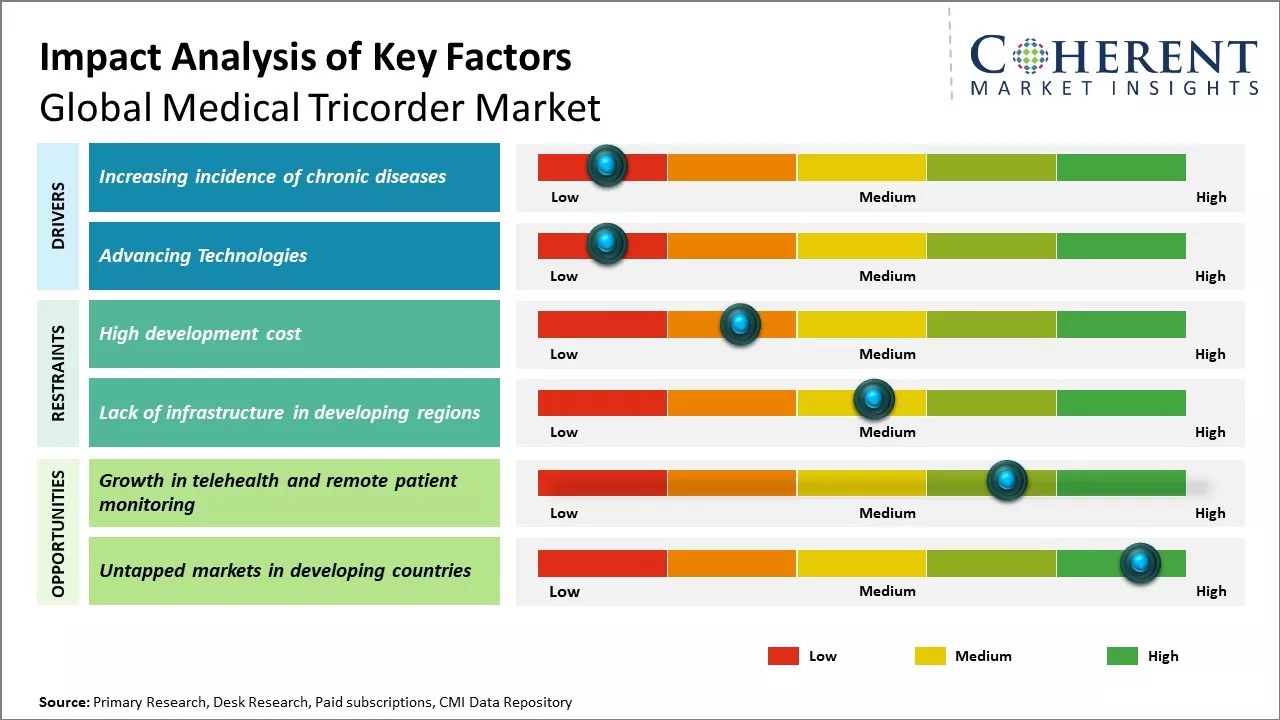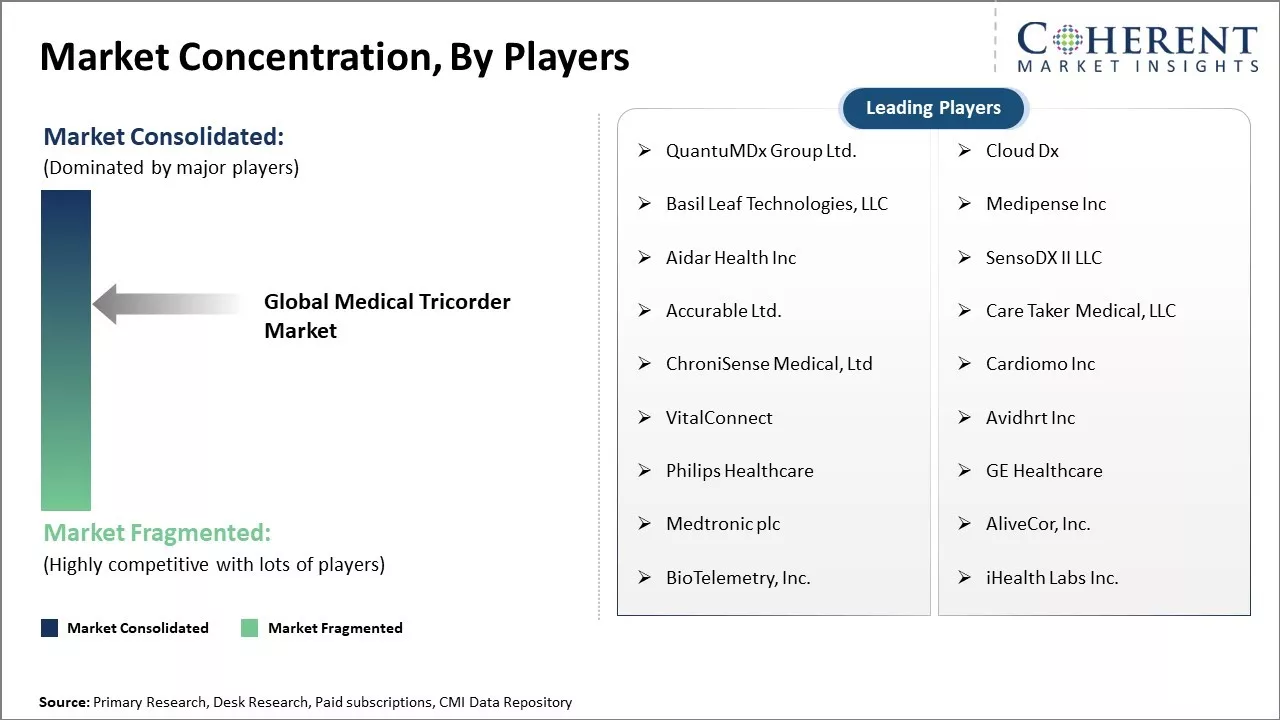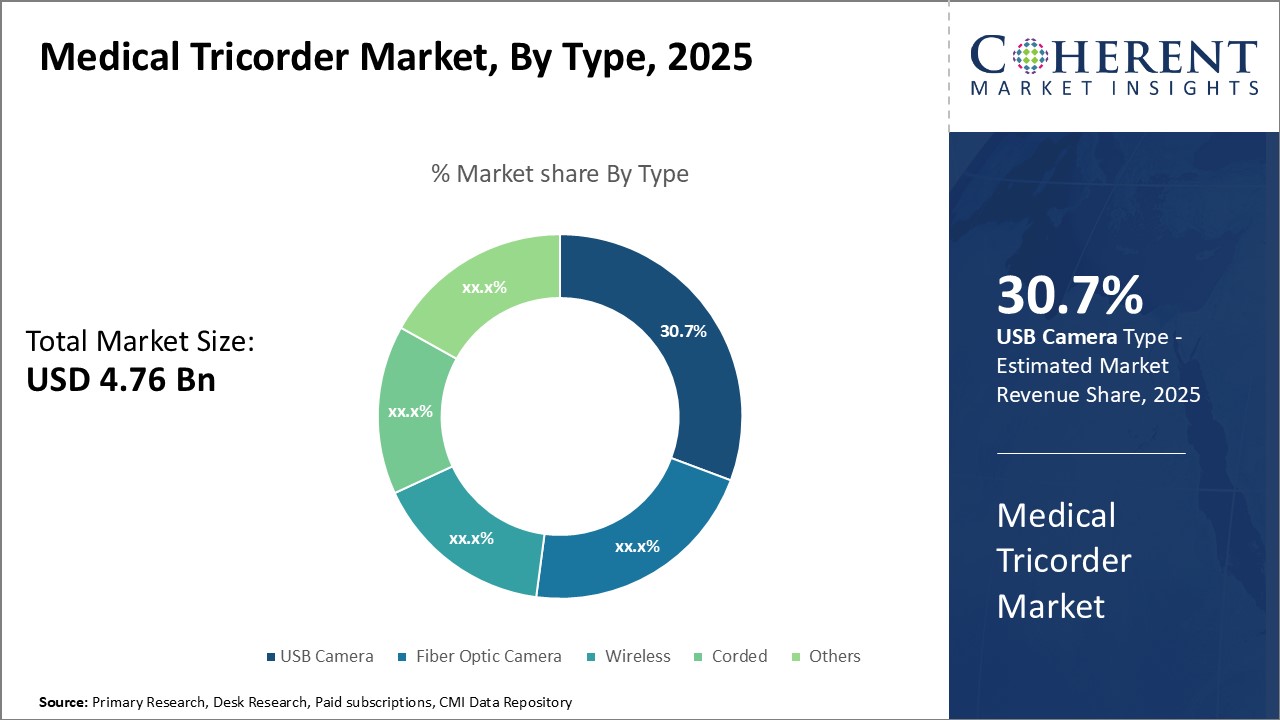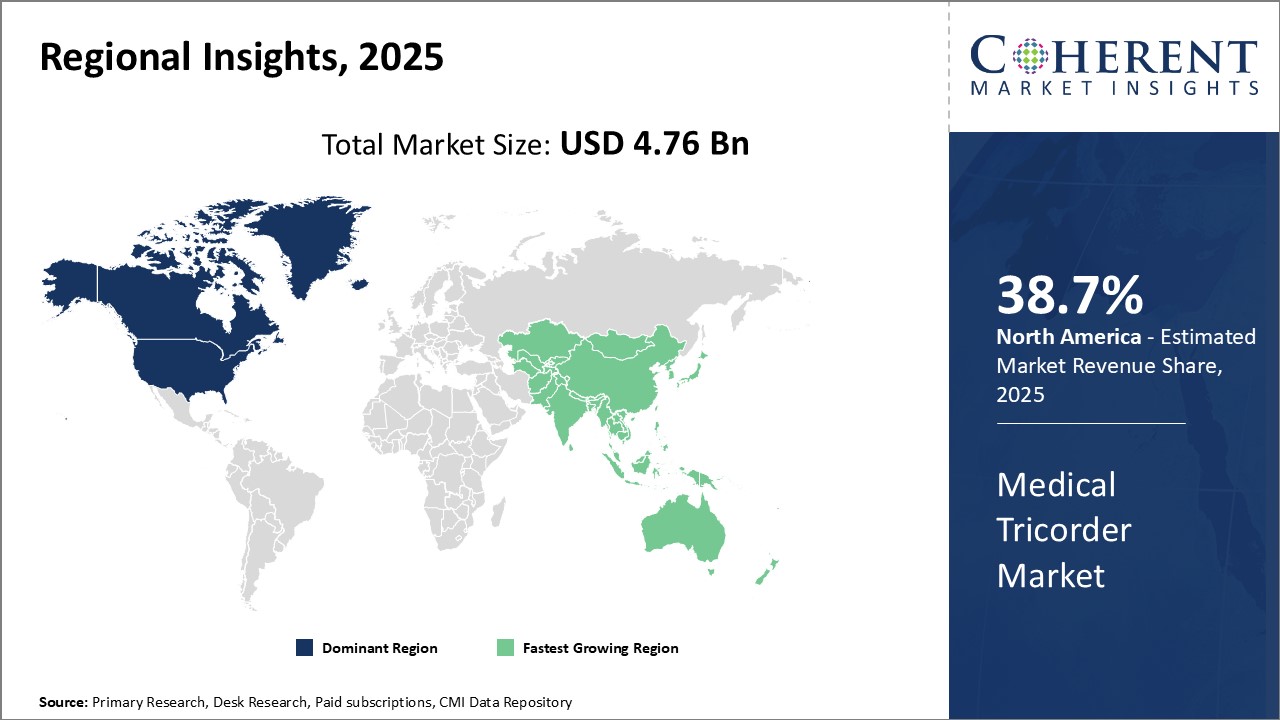Medical Tricorder Market Size and Trends
Global medical tricorder market is estimated to be valued at USD 4.76 Bn in 2025 and is expected to reach USD 8.17 Bn by 2032, exhibiting a compound annual growth rate (CAGR) of 8.0% from 2025 to 2032.

Discover market dynamics shaping the industry: Download Free Sample
Rising cases of chronic diseases worldwide coupled with growing need for quick diagnosis can boost demand for medical tricorders. Increasing investments by key players for development of more advanced medical tricorders can also drive the market growth. However, high costs associated with tricorder devices can hamper the market growth. Ongoing research & development for development of more compact and affordable medical tricorders offers lucrative opportunities for market players in the near future.
Increasing incidence of chronic diseases
Increasing incidence of chronic diseases globally can drive the global medical tricorder market growth. Chronic diseases like cardiovascular diseases, diabetes, cancer, and others require constant monitoring of various vital signs and parameters of patients. Medical tricorders help in remote and frequent monitoring of patients suffering from chronic conditions without requiring them to visit hospitals or clinics repeatedly. This facilitates early detection of health abnormalities and ensures timely clinical interventions. Medical tricorders offer round-the-clock monitoring that helps in early detection of deteriorations in health parameters, which can prevent disease complications and expensive emergency hospitalizations. Medical tricorder can continuously track blood glucose, blood pressure, respiration rate, and others of diabetes patients and alert caregivers if the levels go out of control range. This allows timely adjustment of medications under medical guidance and reduces risks of long-term diabetes complications. The future generation of medical tricorders is expected to integrate more sensors and features of physical examinations for comprehensive health assessment. With ongoing research and technological advancements, medical tricorders are poised to transform chronic disease management and drive the market growth in the near future. For instance, in June 2021, according to an article published by World Health Organization (WHO), cardiovascular diseases rank as the primary cause of death worldwide.
According to an article published by World Health Organization (WHO)in April 2021 on Non-Communicable Diseases, 17.9 million deaths are attributed to cardiovascular diseases annually, and 1.5 million deaths are linked to diabetes.
Market Concentration and Competitive Landscape

Get actionable strategies to beat competition: Download Free Sample
Advancing Technologies
Rapid advancement of technologies in the field of healthcare can drive the market growth. There has been ongoing research and development by major players to create portable medical devices that can perform variety of diagnostic tests with high accuracy. The focus is on developing multidisciplinary diagnostics options by integrating variety of sensors, imaging capabilities and integrated connectivity. This will enable tricorders to examine multiple body systems from anatomical to physiological level and provide comprehensive assessment of patient's condition. The emerging technologies like miniaturized sensors, nanotechnology, artificial intelligence and cloud connectivity are being leveraged to design innovative generation of tricorders. This will allow tricorders to go beyond basic vital sign monitoring and perform complex analysis of blood, urine, biochemical and genetic samples. The integration of advanced sensors allows non-invasive collection of wider diagnostic data related to conditions like diabetes, respiratory illnesses, cardiovascular diseases and certain types of cancer. Furthermore, AI capabilities boosts the analytical abilities of tricorders to recognize patterns, identify abnormalities and arrive at probable diagnosis. The integration of cloud and wireless connectivity enables real-time data transmission to clinicians for remote analysis and monitoring of patients.
Key Takeaways from Analyst:
Global medical tricorder market growth is driven by factors like rising prevalence of chronic diseases, growing need for affordable and portable healthcare monitoring devices, and increasing investment in healthcare technology. However, lengthy approval processes for new medical devices and high costs associated with tricorder development can hamper the market growth.
North America currently dominates the market due to high healthcare spending and presence of key players in the region. However, Asia Pacific is expected to witness the fastest growth due to expanding medical tourism industry, rising disposable incomes, and growing focus of players to tap opportunities in emerging countries. Within Asia Pacific, China and India are likely to offer most lucrative prospects for medical tricorder manufacturers during the forecast period.
Integrating tricorders with artificial intelligence for advanced diagnostics, development of pediatric versions for monitoring child health, and designing multi-purpose devices that can serve both clinical and consumer applications can offer market growth opportunities. Key players are investing in R&D to develop miniaturized versions with enhanced capabilities. Collaboration with healthcare providers and tech giants can r help players strengthen distribution channels and market presence.
Market Challenges: High development cost
The high development cost can hamper the global medical tricorder market growth. Developing a medical tricorder involves massive research and development investments as it requires integrating multiple advanced technologies like AI, sensors, imaging, and others into a portable handheld device. This level of multi-disciplinary integration poses significant technical challenges and requires extensive testing before the product can be commercialized.
According to the data by the U.S. Department of Health and Human Services, it costs an average of US$ 2.6 billion to develop a new drug and bring it to market. Developing a medical device would involve costs at a similar scale considering a tricorder aims to diagnose diseases, monitor vital signs and function like a miniature medical lab. The high initial investments deter many companies, especially startups and mid-sized firms, from entering this market. Only large healthcare companies and well-funded research institutes possess the necessary financial resources to undertake such high-risk projects. Besides product development costs, extensive clinical validation is also required before a medical tricorder can be deployed for clinical use. Its diagnostics and disease detection capabilities need to be tested on large patient datasets and the results must be compared with current diagnostic methods. This clinical trial phase further increases expenses.
Market Opportunities: Growth in telehealth and remote patient monitoring
The COVID-19 pandemic accelerated the adoption of telehealth and remote patient monitoring on an unprecedented scale globally. As millions stayed home to curb the spread of the virus, virtual care options helped overcome barriers to access healthcare. According to the United Nations, over 1.57 billion online consultations were held worldwide from March 2020 to March 2021 as people utilized telemedicine to receive care and advice while maintaining social distance. This massive increase in digital health adoption can offer new growth opportunities. Tricorders could greatly assist the expansion of telehealth and remote monitoring technologies by enabling more comprehensive virtual care and decentralized healthcare delivery outside of traditional clinical settings. With their multi-diagnostic functionalities, medical tricorders could empower consumers and patients to reliably monitor their health, spot early signs of illnesses, and share vital signs and symptom data with providers for prompt virtual follow-ups and interventions. This promising application of tricorders could help bypass many limitations of conventional remote monitoring devices and address issues like device cost, usability challenges, and limited parameter monitoring. If integrated seamlessly with telehealth platforms, tricorders may facilitate more efficient virtual consultations, help manage chronic diseases better, and allow specialists to track high-risk patients more closely from a distance.

Discover high revenue pocket segments and roadmap to it: Download Free Sample
By Type - Convenient connectivity boosts USB camera popularity
In terms of type, USB camera segment is estimated to contribute the highest market share of 30.7% in 2025, owing to its convenient connectivity. USB cameras can be simply plug into any device with a USB port, thus, eliminating the need for additional cables, batteries, or pairing with devices. This makes them exceptionally user-friendly and easily integrated with medical equipment like tricorders. USB cameras are also more affordable than other wired or wireless options, as the technology is widely available. For medical professionals and patients on- the- go, USB cameras provide hassle-free snapshots and video exams without bulky accessories. Their plug-and-play operation streamlines diagnostic workflows. As telehealth continues expanding globally, USB cameras remove geographical barriers to quality healthcare by facilitating remote patient monitoring. Their connectivity remains reliable across urban and rural settings alike.
By Application - Diagnostic primacy drives diagnosis segment
In terms of application, diagnosis segment is estimated to contribute the highest market share of 60.6% in 2025, owing to tricorders’ critical role in front-line medical evaluation and care. As the primary tool for examining and assessing patients, diagnostic tricorders must integrate a wide array of scrutinizing sensors, advanced imaging, and comprehensive analytical software. This enables comprehensive physical readings, scans, and lab work from a single portable device. Rapid and accurate diagnoses are crucial for determining accurate treatment plans and improving health outcomes. For doctors and nurses on the frontlines of primary care, diagnostic tricorders are a vital ally in expediting the diagnostic process and allocating healthcare resources more effectively. Their round-the-clock scanning capabilities also aid remote monitoring of chronic illnesses.
By End User - Institutional infrastructure drives hospital segment
In terms of end user, hospitals segment is estimated to contribute the highest market share of 50.5% in 2025, owing to advantageous institutional infrastructure. As the lynchpin of medical ecosystems, hospitals leverage expansive networks of specialized facilities, funding, and skilled professionals to progressively incorporate innovative diagnostic technologies. Their leadership in clinical research boosts early adoption of advanced tricorders optimized for diagnosing complex or rare conditions. Moreover, hospitals can standardize tricorder protocols across large patient pools to maximize big data-driven insights. Integrating medical tricorders into digital hospital workflows helps streamline handoffs between departments while facilitating remote collaboration among specialists. As trusted nodes within existing healthcare infrastructure, hospitals promote tricorders as a flagship diagnostic tool accessible to all.
Regional Insights

Need a Different Region or Segment? Download Free Sample
North America dominates the medical tricorder market with an estimated market share of 38.7% in 2025, due to presence of major medical device companies in the region as well as higher healthcare expenditure. Countries like the U.S. spend disproportionately more on healthcare as compared to other developed nations.
The U.S. accounts for the largest share of the North American market due to well-established research and development infrastructure and favorable regulatory environment for new medical technologies. Many leading players have their headquarters located in the U.S. and focuses on developing innovative AI and IoT enabled solutions. This has ensured that North American physicians and patients have early access to cutting-edge clinical-grade tricorder devices. However, regulatory hurdles and stringent approval pathways have slowed down the commercialization process.medical device manufacturers remain focused on obtaining necessary clearance and bringing tricorders to market safely.
Asia Pacific is witnessing the fastest growth and gradually emerging as an important hub. Rapid digital transformation of the healthcare sector across nations like China, India and South Korea boosts adoption of tricorder. Private medical device companies from North America and Europe are increasingly setting up manufacturing units to cater to the rising local demand. This help to bring down product costs which is an important factor for success in price-sensitive markets.
Market Report Scope
Medical Tricorder Market Report Coverage
| Report Coverage | Details | ||
|---|---|---|---|
| Base Year: | 2024 | Market Size in 2025: | USD 4.76 Bn |
| Historical Data for: | 2020 To 2024 | Forecast Period: | 2025 To 2032 |
| Forecast Period 2025 to 2032 CAGR: | 8.0% | 2032 Value Projection: | USD 8.17 Bn |
| Geographies covered: |
|
||
| Segments covered: |
|
||
| Companies covered: |
QuantuMDx Group Ltd., Cloud Dx, Basil Leaf Technologies, LLC, Medipense Inc, Aidar Health Inc, SensoDX II LLC, Accurable Ltd., Care Taker Medical, LLC, ChroniSense Medical, Ltd, Cardiomo Inc, VitalConnect, Avidhrt Inc, Philips Healthcare, GE Healthcare, Medtronic plc, AliveCor, Inc., BioTelemetry, Inc., iHealth Labs Inc. |
||
| Growth Drivers: |
|
||
| Restraints & Challenges: |
|
||
Uncover macros and micros vetted on 75+ parameters: Get instant access to report
Market Segmentation
- Type Insights (Revenue, USD Bn, 2020 - 2032)
- USB Camera
- Fiber Optic Camera
- Wireless
- Corded
- Others
- Application Insights (Revenue, USD Bn, 2020 - 2032)
- Diagnosis
- Monitoring
- Others
- End User Insights (Revenue, USD Bn, 2020 - 2032)
- Hospitals
- Clinics
- Home Care Settings
- Others
- Regional Insights (Revenue, USD Bn, 2020 - 2032)
- North America
- U.S.
- Canada
- Latin America
- Brazil
- Argentina
- Mexico
- Rest of Latin America
- Europe
- Germany
- U.K.
- Spain
- France
- Italy
- Russia
- Rest of Europe
- Asia Pacific
- China
- India
- Japan
- Australia
- South Korea
- ASEAN
- Rest of Asia Pacific
- Middle East
- GCC Countries
- Israel
- Rest of Middle East
- Africa
- South Africa
- North Africa
- Central Africa
- North America
- Key Players Insights
- QuantuMDx Group Ltd.
- Cloud Dx
- Basil Leaf Technologies, LLC
- Medipense Inc
- Aidar Health Inc
- SensoDX II LLC
- Accurable Ltd.
- Care Taker Medical, LLC
- ChroniSense Medical, Ltd
- Cardiomo Inc
- VitalConnect
- Avidhrt Inc
- Philips Healthcare
- GE Healthcare
- Medtronic plc
- AliveCor, Inc.
- BioTelemetry, Inc.
- iHealth Labs Inc.
Share
Share
About Author
Komal Dighe is a Management Consultant with over 8 years of experience in market research and consulting. She excels in managing and delivering high-quality insights and solutions in Health-tech Consulting reports. Her expertise encompasses conducting both primary and secondary research, effectively addressing client requirements, and excelling in market estimation and forecast. Her comprehensive approach ensures that clients receive thorough and accurate analyses, enabling them to make informed decisions and capitalize on market opportunities.
Missing comfort of reading report in your local language? Find your preferred language :
Transform your Strategy with Exclusive Trending Reports :
Frequently Asked Questions
EXISTING CLIENTELE
Joining thousands of companies around the world committed to making the Excellent Business Solutions.
View All Our Clients
